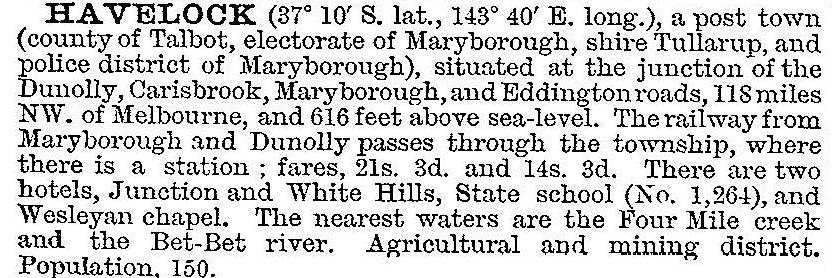Havelock
Havelock is a rural locality and a former gold mining town 10 km north of Maryborough on the road and railway line to Dunolly.
Gold was discovered at Havelock in 1858, and the resulting settlement was named after Major General Sir Henry Havelock who died in 1857 during the Indian Mutiny. The remnants of the original settler’s homestead are about 4 km east of Havelock near the Tullaroop or Deep Creek – the Charlotte Plains homestead (1843) built by the Simson family.
Gold was readily won around Havelock, and the leads were also highly productive. Intermittent rushes to various finds continued until 1864. Deep alluvial leads were mined until the early 1900s, the Main Lead mines lasting until 1918. All the mining activity, however, did not generate a large local population, as many miners were transient or cycled from Maryborough. A school was opened in 1870, but the average attendance was usually under 30. The Havelock railway station was opened on the Maryborough to Dunolly line in 1874.
Havelock was described in 1903 in the Australian handbook:

Havelock is surrounded by State forest to its west, south and east, concealing many old mine workings. There was a short lived tree nursery (1889-1902). The Timor State forest is about 2 km to the west.
Havelock school closed in 1927 and the population fell to about 50, at which it remained until the 1970s when some house building activity began. Havelock’s census populations have been:
| census date | population |
|---|---|
| 1881 | 265 |
| 1891 | 135 |
| 1911 | 197 |
| 1921 | 94 |
| 1933 | 53 |
Further Reading
Barbara Willis, Footprints: a history of the Shire of Tullaroop, Shire of Tullaroop, 1988
John Alderson, Havelock vol 1, Havelock, 1975


